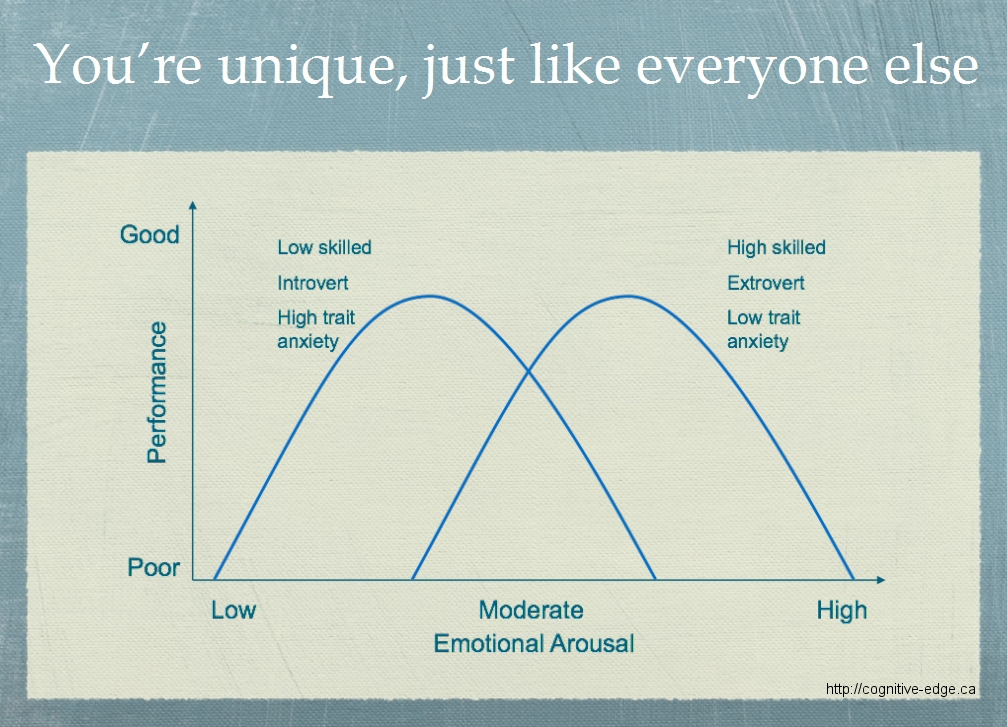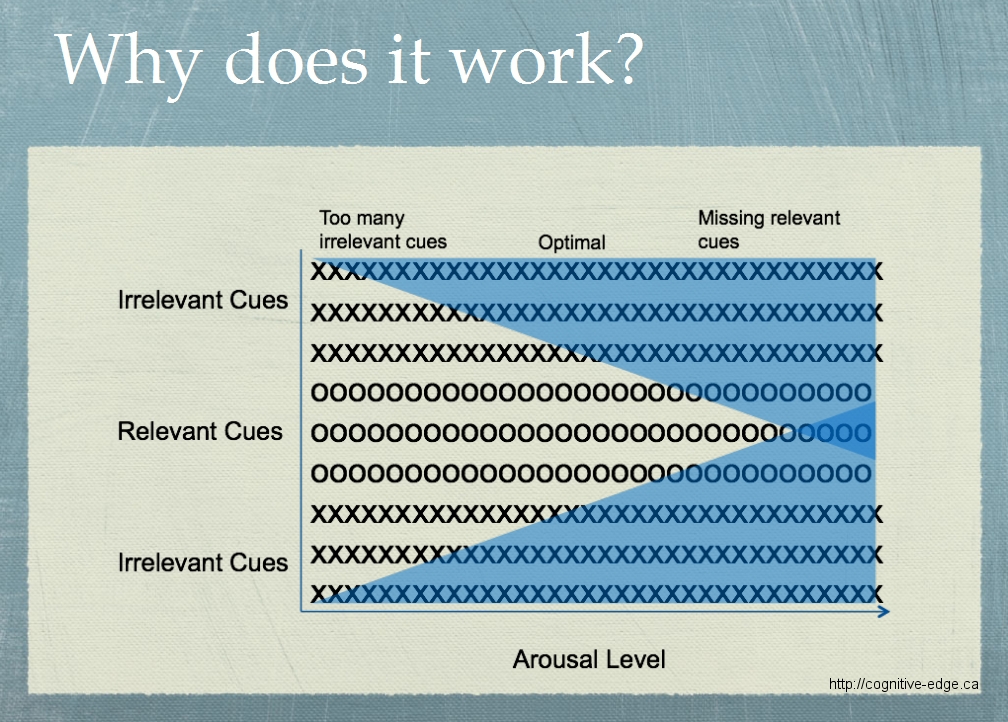

‘Before everything else, getting ready is the secret of success.’ – Henry Ford
Just a couple of notes to start. First, I want to remind everyone that the Pre-Competition Routine for Big Events Program is in the home stretch. There’s only 3 more days until the bundle deal for the program is gone. Visit http://precompetition.cognitive-edge.ca to get involved.
Second, for those who have already jumped in, it’s been pointed out by many of our American members that the first webinar date is Thanksgiving in the US. Sorry about that, it wasn’t on any of our calendars up here in Canada. We are going to reschedule, so stay tuned. With that out of the way…
Last week in my guest post on Susan Garrett’s blog, I introduced the idea of an Ideal Performance State (IPS). When you achieve your IPS you often achieve your personal best performances. A lot of people call it being “in the zone” or in “flow”. It’s a great place to be.
To achieve your IPS you need to manage your physical, mental, and emotional self. A key factor in this equation is your arousal level. Your arousal level is the intensity of your thoughts, feelings, and behaviour.
A great analogy that I think most of us can relate to is that of a car. Think of arousal as the RPM (revolutions per minute) of your engine. When you are trying to get from point A to point B in your car, you have to use the accelerator to control your RPM. You need to get the RPM’s up high enough to start the car moving. If you don’t, the car will stall out.
On the reverse, if you hit the accelerator too hard and the RPM’s shoot way up, you accelerate out of control and might crash. The trick is learning how to control the RPM and knowing what is the appropriate level for a given situation (e.g., driving in a parking lot versus passing a tractor-trailer on the interstate). As anyone who has taken out a student driver knows, these things aren’t easy to do without practice.
Just like the car, the athlete needs to regulate their arousal level for optimal performance. In the graph below, I have presented the relationship between one’s arousal level and one’s performance. Your IPS is a small range of arousal where your performance is at its highest.

When I ask athletes about how they felt just before a big competition, I often get things like “I was nervous” or “I felt sick to my stomach”. And their performance, as you can imagine wasn’t at the level they wanted. These athletes are on the far right side of the graph. It’s fairly intuitive, they need to use some of their psychological skills to reduce their arousal levels and bring them closer to their IPS.
And other athletes, when I speak with them after a poor performance, say “I don’t know why I performed so poorly, I wasn’t nervous at all”. This situation isn’t quite as intuitive, but often times, it’s arousal again becoming a problem. These athletes are on the far left side of the graph and don’t have enough intensity. Again, using some of their psychological skills, they can increase their arousal levels and move themselves closer to their IPS.
Now the relationship you have between your arousal levels and your performance isn’t a one-size fits all thing. In the second graph, you can see that your personality, the environment, and your skill level can affect it.

The curve on the left is an example of someone who may be an introvert, or is normally an anxious person, or more importantly in a sport context, may be trying to execute skills that aren’t well learned. What you can see is that with a little bit of arousal, this person is able to achieve their IPS. Somewhere in between low and moderate levels of arousal.
For athletes with normally low levels of anxiety, or who are extroverted, or are very proficient in their skills, the curve shifts over to the right. Here, low levels of arousal do nothing to help their performance. They need to use their psychological skills training to boost their arousal. For these athletes, only the extreme end of arousal causes their performance to break down. To reach their IPS they need to get their arousal levels up towards the high end of the scale.
I also want to point out that the requirements of your sport plays a huge role in this relationship. The levels of arousal that are effective for an agility handler or a figure skater won’t be the same for a football or rugby player.
Why Does This Happen?
During a competition or in practice too, there are things (cues) that are important for you to pay attention to in order to be successful. They can be things like your position on the field, your opponent’s movements, the proper way you need to move your leg to get maximum acceleration after a direction change. But there are also a lot of irrelevant cues too. Like what clothing spectators are wearing, the type of music that may be playing in the background, or if your left foot is itchy.
The figure below shows you what I mean. When your arousal level is too low, you don’t filter out enough of the irrelevant cues (the X’s). You’re distracted and not enough of your attentional focus is on the right things – so your performance suffers. When you’re in your IPS, you’ve found that sweet spot where you can filter out all the unnecessary stuff and direct your full attention to everything that’s important (the O’s). But, as your arousal level pushes you beyond your IPS, you begin filtering out some pretty important things. You get “tunnel vision” and again, your performance will not be what you had hoped it would be.

One idea about why this relationship exists is that your arousal has a direct impact on your ability to focus your attentional resources. From the graph above, you can see that as you move from left (low) to right (high) along the arousal axis, the number of cues (both X’s and O’s) you are able to pay attention to shrinks. With an increase in arousal you begin filtering out cues (shaded blue).
A great way you can make sure you land in your IPS and don’t find yourself either to high or too low when it comes to your arousal level is to develop a killer pre-competition routine. You can find out more details about our program at http://precompetition.cognitive-edge.ca
Leave A Reply (10 comments so far)
The comments are closed.
Bonnie
13 years ago
I know I am sometimes asked to help organize a trial and prepare running orders and be a trial secretary, anytime I am required to do these extra things I find I have poor perfomances. If I am asked to do alot of these tasks I won’t run my dog in that trial. At trials where I am just another competitor I make course building one of my helper jobs, this gives me an opportunity to see the course being built and I can spend time in between runs going over my course maps and preparing my dog for the next run.
Karen
13 years ago
This was wonderful to see graphically. I am introverted & I do feel that I have a high anxiety trait in certain situations. I do have a pre-competition routine but it was lacking visualization & positive self-talk so now I’m beefing it up – I’m eager to try it this weekend to see if it helps me find & maintain my IPS a little easier.
WK
13 years ago
With the course being offered between you and Susan Garrett, how am I to be assured, I don’t hang about waiting for you to get your dimdim webinar service to operate correctly. I’m really disappointed that Susan has pushed forward with this new program without assurances that we are not going to be wasting our time for you to get it operational.
John Cullen
13 years ago
Hi WK,
Susan and I are aware of the issues with some of the previous webinars and we are looking at alternative delivery platforms. We will be recording them as well so that if you can’t make the date or you just want to review, they will be available when you want them.
Meghan
13 years ago
How do we sign in to get the webinar info?
John Cullen
13 years ago
Hi Meghan,
The membership area is almost ready. You will get an email letting you know how to log in. The tentative dates for the webinars are November 27, December 8, and December 15.
kay
13 years ago
I had a great deal of frustration trying upload the pre-competition video on my Apple computer, because the links didn’t work; three days after my first request for help…… a link that worked! I will not be home on November 27th so I hope the webinar recording will be easy to access and not require as much effort.
Trudie
13 years ago
I have a question I wondered anyone else has encountered. You go to an agility event and you know it is silly, but you had a previous not-very-good-run experience with the judge. How to get rid of bad karma anxiety which may be sub-consciously tainting your mental game? I find if I’ve had a good experience with certain judges I feel more at ease before a run. How can I include this in my pre-competition routine?
Second. After a day when I have done well, or I am satisfied with my effort, I always think, I can hardly wait for the next competition! I feel in a good state and I say to myself, I must remember to get into this same state for the next competition. I try to recall how I feel. Alas, 4 weeks may go by and it seems I have to go through the whole process of stage fright again every time.
Linda Newby Reimann
13 years ago
Will we access the webinar through the member site on 11-27? You will provide a link?
Thanks,
Linda Newby
John Cullen
13 years ago
Yes. When you login to the member area, there will be a link to click on to get to the webinar.